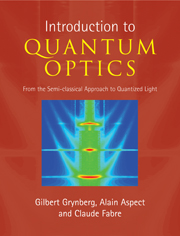Book contents
- Frontmatter
- Contents
- Foreword
- Preface
- Acknowledgements
- Part I Semi-classical description of matterlight interaction
- 1 The evolution of interacting quantum systems
- Complement 1A: A continuum of variable width
- Complement 1B: Transition induced by a random broadband perturbation
- 2 The semi-classical approach: atoms interacting with a classical electromagnetic field
- Complement 2A: Classical model of the atom-field interaction: the Lorentz model
- Complement 2B: Selection rules for electric dipole transitions. Applications to resonance fluorescence and optical pumping
- Complement 2C: The density matrix and the optical Bloch equations
- Complement 2D: Manipulation of atomic coherences
- Complement 2E: The photoelectric effect
- 3 Principles of lasers
- Complement 3A: The resonant Fabry–Perot cavity
- Complement 3B: The transverse modes of a laser: Gaussian beams
- Complement 3C: Laser light and incoherent light: energy density and number of photons per mode
- Complement 3D: The spectral width of a laser: the Schawlow–Townes limit
- Complement 3E: The laser as energy source
- Complement 3F: The laser as source of coherent light
- Complement 3G: Nonlinear spectroscopy
- Part II Quantum description of light and its interaction with matter
- Part III Applying both approaches
- Index
1 - The evolution of interacting quantum systems
Published online by Cambridge University Press: 05 August 2012
- Frontmatter
- Contents
- Foreword
- Preface
- Acknowledgements
- Part I Semi-classical description of matterlight interaction
- 1 The evolution of interacting quantum systems
- Complement 1A: A continuum of variable width
- Complement 1B: Transition induced by a random broadband perturbation
- 2 The semi-classical approach: atoms interacting with a classical electromagnetic field
- Complement 2A: Classical model of the atom-field interaction: the Lorentz model
- Complement 2B: Selection rules for electric dipole transitions. Applications to resonance fluorescence and optical pumping
- Complement 2C: The density matrix and the optical Bloch equations
- Complement 2D: Manipulation of atomic coherences
- Complement 2E: The photoelectric effect
- 3 Principles of lasers
- Complement 3A: The resonant Fabry–Perot cavity
- Complement 3B: The transverse modes of a laser: Gaussian beams
- Complement 3C: Laser light and incoherent light: energy density and number of photons per mode
- Complement 3D: The spectral width of a laser: the Schawlow–Townes limit
- Complement 3E: The laser as energy source
- Complement 3F: The laser as source of coherent light
- Complement 3G: Nonlinear spectroscopy
- Part II Quantum description of light and its interaction with matter
- Part III Applying both approaches
- Index
Summary
In this work we shall study the interaction of matter and light. In so doing we shall rely heavily on the description of such processes provided by quantum mechanics. This appears on a number of levels: firstly, a quantum description of matter is indispensable if one wants to understand on the microscopic scale the different kinds of interaction processes that can occur. Secondly, a quantum description of light often turns out to be useful, sometimes necessary, to better understand these processes. We shall study phenomena such as spontaneous emission, which can only be properly treated by a theory taking into account the quantum nature of both light and matter.
In the following chapters we shall address, amongst others, the following question: ‘given an atom prepared at a given time in a particular state and subjected from this time onwards to electromagnetic radiation, what is the state of the atom and radiation at any later moment in time?’ In order to be able to answer this question it will be necessary for us to know how to calculate the evolution of a quantum system in a small number of typical situations. These methods we shall demonstrate in the first chapter.
The evolution of the coupled atom–light system depends on the temporal dependence of the applied light field, which could, for example, be applied from a given moment and thereafter remain unchanged in intensity, or, perhaps, be appreciable only for a finite period of time (pulsed excitation).
- Type
- Chapter
- Information
- Introduction to Quantum OpticsFrom the Semi-classical Approach to Quantized Light, pp. 3 - 33Publisher: Cambridge University PressPrint publication year: 2010



